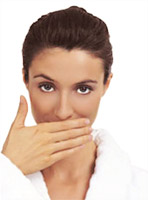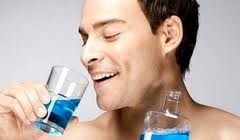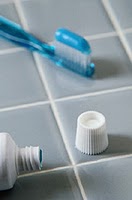 Bad breath is also termed as halitosis/fetor oris/breath malodor and foul breath. Halitosis is a term used to describe noticeably unpleasant smell exhaled in breathing. It affects a large proportion of population,estimated to be the third most frequent reason for seeking dental treatment , following tooth decay and periodontal disease. Bad breath increases during the day (maybe due to stress or fasting), eating certain foods (like garlic, onions,meat,fish and cheese), smoking and alcohol assumption. The mouth is dry and inactive during the night, the bad breath is usually worse when you wake up (morning breath)Â
Bad breath is also termed as halitosis/fetor oris/breath malodor and foul breath. Halitosis is a term used to describe noticeably unpleasant smell exhaled in breathing. It affects a large proportion of population,estimated to be the third most frequent reason for seeking dental treatment , following tooth decay and periodontal disease. Bad breath increases during the day (maybe due to stress or fasting), eating certain foods (like garlic, onions,meat,fish and cheese), smoking and alcohol assumption. The mouth is dry and inactive during the night, the bad breath is usually worse when you wake up (morning breath)Â
Classification of Halitosis / Bad Breath
1. Genuine Halitosis
– Physiologic Halitosis
-Â Pathologic Halitosis : Oral & Extraoral
 2. Pseudo Halitosis
The bad breath is not perceived by others but you complain of the existance.
3. Â Halitophobia
After treatment of genuine halitosis or pseudo-halitosis, the patient persists in believing that she/he has bad breath.
Causes of Bad Breath
Bad Breath is usually caused by the breakdown of proteins by bacteria somewhere in the mouth. At least 90 % of the bad breath comes from the oral cavity/mouth while 10% has systemic or normal causes.
- Physiologic Causes : Â
a ) Mouth Breathing :Â There are over 600 types of bacteria found in the average mouth. Several dozen of these can produce high levels of foul odors when incubated in the laboratory. The odors are produced mainly due to the breakdown of proteins into individual amino acids, followed by the further breakdown of certain amino acids to produce detectable foul gases. For example, the breakdown of cysteine and methionine produce hydrogen sulfide and methyl mercaptan, respectively. Volatile sulfur compounds have been shown to be statistically associated with oral malodor levels, and usually decrease following successful treatment.
b) Medications
c) Â Aging and poor dental hygieneÂ
d) Fasting/Starvation
e) Tobacco
f)Foods ( Onions, Garlic n etc ) and Alcohol
- Pathologic HalitosisÂ
Oral and other contributing factors such as :
a) Periodontal Infection : Odor from subgingival dental biofilm. Specific diseases like Acute Necrotizing Ulcerative Gingivitis and Pericoronitis
b) Tongue coating harbours microorganisms
c) Stomatitis, Xerostomia
d) Faulty restorations retaining food and bacteria
e) Unclean dentures
f) Oral pathologic lesions like oral cancers and candidiasis
g) Parotitis, Cleft Palate
h) Aphthous ulcers, Dental Abscesses
Systemic and Extra Oral Factors :
a) Nasal Infections like rhinitis, sinusitis, tumours and foreign bodies
b)Diseases of Gastrointestinal Tract (GIT) like Hiatus hernia, carcinomas, GERD ( Gastroesophageal Reflux Disorder)
c)Pulmonary Infections like bronchitis, pneumonia, tuberculosis, carcinomas
d) Certain hormonal changes that occur during ovulation, menstruation, pregnancy and menopause
e) Systemic diseases like diabetes mellitus, hepatic failure, renal failure, uremia, blood dyscrasias, dehydration, fever, cirrhosis of liver
Diagnosis of Bad Breath
Self Diagnosis
1. Lick the back of your hand. Let it dry for a few seconds and then smell. If you notice and odor, you have a breath disorder.
2. Place dental floss between your back teeth and then smell the floss.
3. While looking at the mirror, grab the tip of your tongue with a Kleenex and pull it out as far you can. If you see that the very back of your tongue is whitish in color, it may be a sign that you have bad breath.
4. Ask the opinion of someone you can trust. Check your breath several times daily because your breath changes throughout the day.
Professional diagnosis
If bad breath is persistent, and all other medical and dental factors have been ruled out, specialized testing and treatment is required. Hundreds of dental offices and commercial breath clinics now claim to diagnose and treat bad breath.
They often use some of several laboratory methods for diagnosis of bad breath:
1. Halimeter: a portable sulfide monitor used to test for levels of sulfur emissions (to be specific, hydrogen sulfide) in the mouth air. When used properly, this device can be very effective at determining levels of certain VSC-producing bacteria. However, it has drawbacks in clinical applications. For example, other common sulfides (such as mercaptan) are not recorded as easily and can be misrepresented in test results. Certain foods such as garlic and onions produce sulfur in the breath for as long as 48 hours and can result in false readings. The Halimeter is also very sensitive to alcohol, so one should avoid drinking alcohol or using alcohol-containing mouthwashes for at least 12 hours prior to being tested. This analog machine loses sensitivity over time and requires periodic recalibration to remain accurate.
2. Gas chromatography: portable machines, such as the OralChroma, are currently being introduced.[25] This technology is specifically designed to digitally measure molecular levels of the three major VSCs in a sample of mouth air (hydrogen sulfide, methyl mercaptan, and dimethyl sulfide). It is accurate in measuring the sulfur components of the breath and produces visual results in graph form via computer interface.
3.BANA test:Â this test is directed to find the salivary levels of an enzyme indicating the presence of certain halitosis-related bacteria.
4. β-galactosidase test: salivary levels of this enzyme were found to be correlated with oral malodor.
Treatment and Prevention of Bad Breath
1. Improving oral hygience and periodontal health through basic dental care with brushing the teeth twice daily and use mouthwash like Listerine for good oral health
2.  Gently cleaning the tongue surface twice daily is the most effective way to keep bad breath in control; that can be achieved using a tooth brush, tongue cleaner or tongue brush/scraper to wipe off the bacterial biofilm, debris, and mucus.
 Â 3. Chewing gum: Since dry-mouth can increase bacterial buildup and cause or worsen bad breath, chewing sugarless gum can help with the production of saliva, and thereby help to reduce bad breath. Chewing may help particularly when the mouth is dry, or when one cannot perform oral hygiene procedures after meals (especially those meals rich in protein). This aids in provision of saliva, which washes away oral bacteria, has antibacterial properties and promotes mechanical activity which helps cleanse the mouth. Some chewing gums contain special anti-odor ingredients. Chewing on fennel seeds, cinnamon sticks, mastic gum, or fresh parsley are common folk remedies.
 3. Chewing gum: Since dry-mouth can increase bacterial buildup and cause or worsen bad breath, chewing sugarless gum can help with the production of saliva, and thereby help to reduce bad breath. Chewing may help particularly when the mouth is dry, or when one cannot perform oral hygiene procedures after meals (especially those meals rich in protein). This aids in provision of saliva, which washes away oral bacteria, has antibacterial properties and promotes mechanical activity which helps cleanse the mouth. Some chewing gums contain special anti-odor ingredients. Chewing on fennel seeds, cinnamon sticks, mastic gum, or fresh parsley are common folk remedies.
  4. Gargling right before bedtime with an effective mouthwash.Â
 4. Gargling right before bedtime with an effective mouthwash.Â
5. Mint spray

